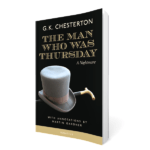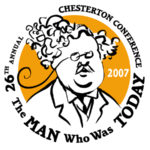At first glance, The Man Who Was Thursday is a detective story filled with poetry and politics. But it is mystery that grows more mysterious, until it is nothing less than the mystery of creation itself.This is Chesterton’s most famous novel. Never out of print since it was first published in 1908, critics immediately hailed it as “amazingly clever,” “a remarkable acrobatic performance,” and “a scurrying, door-slamming farce that ends like a chapter in the Apocalypse.” One reviewer described how he had read it in one sitting and put it down, “completely dazed.” Thirty years later, Orson Welles called it “shamelessly beautiful prose” and made a radio dramatization of it with his Mercury Radio Theater of the Air. (Unfortunately, he upstaged himself two weeks later with a production of H.G. Wells’ War of the Worlds.)
Gabriel Syme is a poet and a police detective. Lucien Gregory is poet and a bomb-throwing anarchist. At the beginning of the novel, Syme infiltrates a secret meeting of anarchists and gets himself elected as “Thursday,” one of the seven members of the High Council of Anarchists. If you think it is paradoxical that there should be a governing body of those dedicated to destroying governing body, a hierarchy for blowing up hierarchies, you might be right. You might also note that the main reason Syme becomes a detective in the first place is because he is a rebel against rebellion. The policeman who recruits him explains that there is a difference between the real anarchists and the innocent ones who merely think rules are bad and should be broken. The real anarchists are something far worse than that. “They mean death. When they say that mankind shall be free at last, they mean that mankind shall commit suicide. When they talk of a paradise without right or wrong, they mean the grave. They have but two objects, to destroy humanity and then themselves.” This is a prophetic description of the philosophy of the “real anarchists” who really would bring us the Culture of Death.
As the story unfolds, Syme soon learns that he is not the only one in disguise. The comparison with the Apocalypse is not unwarranted; this is a book of Revelation, as one symbolic surprise after another is revealed. But even as the masks come off, the biggest question – for both the reader and the characters – is who is Sunday? What is the true identity of the larger than life character who is the supreme head of the anarchists?
“I confess that I should feel a bit afraid of asking Sunday who he really is.”
“Why,” asked the Secretary, “for fear of bombs?”
“No,” said the Professor, “for fear he might tell me.”
But have no fear, I won’t tell you who Sunday is, even if you think you already know the answer. But I will happily give away a bigger surprise, the revelation that this story is not to be compared with the biblical book of Revelation, but rather with the book of Job, the book which Chesterton considered the greatest riddle in all of literature. And even if you know that going in, it won’t help you one bit.
Along the way to the final confrontation, we also get a taste of Chesterton’s social philosophy. Barely noticed by most readers is the enormous common sense that a person with property is not an anarchist. But it’s not just bomb-throwers who are the anarchists and the enemy of the common man. There is another class of people dedicated to a more deceitful destruction of society. They, too, think they can live outside the rules. They are the very rich. “The poor object to being governed badly. The rich object to being governed at all.”
This book is Chesterton at his best. Every scene is perfect. Every line is a gem. His brilliant wit shines in the episode where Syme is looking for any pretense to challenge another council member to a duel. But then he describes with great poignancy Syme’s feelings as he is about to fight the duel in which he will most likely die: “He felt a strange and vivid value in all the earth around him, in the grass under his feet; he felt the love of life in all living things.”
Look through those eyes for a while.


